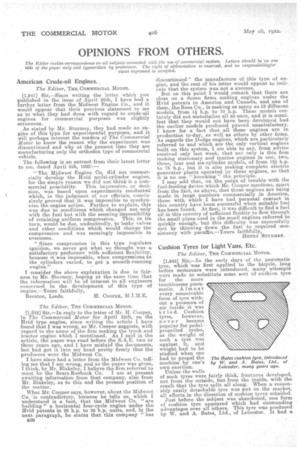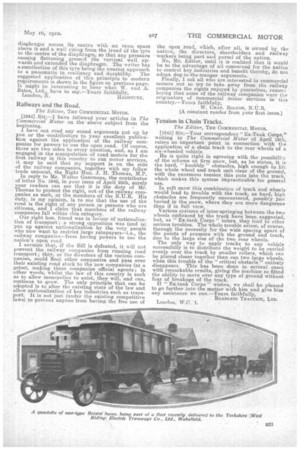OPINIONS FROM OTHERS.
Page 28

Page 29

If you've noticed an error in this article please click here to report it so we can fix it.
The Editor invites correspondence on all subjects connected with the use of commercial motors. Letters should be on one side of the paper only and typewritten by preference. The right of abbreviation is reserved, and no responsibilityfor • views expressed is accepted.
American Crude-oil Engines.
The Editor, THEMOMMERCIAL MOTOR.
[1,941] Sir,—Since writing the letter which you published in the issue of April 25th,. I have had a further letter from the Midwest Engine Co., and it would appear that their previous statement to me as to what they had done with regard to crude-nil engines for commercial purposes was slightly erroneous.
As stated by Mr. Sturmey, they had made an engine of this type for experimental purposes, and it will perhaps interest the readers of The Commercial Motor to know the reason why the experiment was discontinued and why at the present time they are manufacturing only the orthodox typo of commercial vehicle.
The following is an extract from their latest letter to me, dated April 6th, 1922 :— " The Midwest Engine Co. did not commercially develop the livid multi-cylinder engine, for the simple reason we did not think it a com
mercial possibility. This impression, or decision was based upon experiments conducted which, in the judgment of our officials, conclusively proved that it was impossible to synchronize the engine action. Further to explain, this was due to conditions which changed not only with the fuel but with the seeming impossibility of retaining uniform compression. This, in its turn, would be due, undoubtedly, to leaky valves and other conditions which would change the compression and was seemingly impossible to overcome.
" Since compression in this type regulates ignition, we never got what we thought was a satisfactory performer with sufficient flexibility, because it was impossible, when compressions in the cylinders varied, to get a smooth-running engine."
I consider the above explanation is due in fairness to Mr. Sturmey, hoping at the same time that the information will be of interest to all engineers concerned in the development of this type of engine.—Yours faithfully, Beeston, Leeds. H. COOPER, M.I.M.E,
The Editor, THE COMMERCIAL MOTOR.
[1,6-42] Sir,—In reply to the letter of Mr. H. Cooper, in The Commercial Motor for April 25th, re the livid type engine, since writing the article I have found that I was wrong, as Mr. Cooper suggests, with regard to the name of the firm making the truck and • tractor engine which I mentioned. As I said in the article, the paper was read before the S.A.E. two or three years ago, and I have mislaid the documents, but had got it into my head pretty firmly that the producers were the Midwest Co.
I have since had a letter from the Midwest Co. telling me that I am wrong, and as the paper was given, I think, by Mr. Blakeley, I believe the firm referred to must be the Sears-Roebuck Co. I am at present awaiting information from that company, also from Mr. Blakeley, as to this and the present position of the matter.
What Mr. Cooper says, however, about the Midwest Co. 'is contradictory, because he tells us, which I understand is a fact, that the Midwest Co. "are building" a horizontal four-cycle engine under the livid patents in 20 h.p. to 35 -11.p. units, and, in the next paragraph, he states that this company "has
B30 discontinued" the manufacture of this type of engine, and the rest of his letter would appear to indicate that the system was not a success.
But on this point I would remark that there are close on a dozen firms making engines under the livid patents in America and Canada, and one of them, the Boos Co., is making as many as 13 different models, from 1i h.p. to 70 h.p. These models certainly did not materialize all at once, and it is manifest that they would not have been developed had the earlier models produced proved unsatisfactory. I know for a fact that all these engines are in production to-day, as well as others by other firms. As regards the Dodge engines, which are particularly referred to and which are the only vertical engines built on this system, I am able to say, from advice received only last week, that net only is this firm making stationary and marine engines in one, two, three, four and six-cylinder models, of from 12i h.p. to 75 h.p., but it is also making complete electric generator plants operated by these engines, so that it is no use " knocking " the principle.
I may add that, on the point of trouble with the fuel-feeding device which Mr. Cooper mentions, apart from the fact, as above, that these engines are being made in large numbers • commercially in America, those with which I have had personal contact in this country have been successful when suitable fuel has been found. At first, it was difficult to find a fuel oil in this country of sufficient fluidity to flow through the small pipes used in the small engines referred to quickly enough, but this difficulty was successfully met by thinning down the fuel to required consistency with paraffin.—Yours faithfully, HENRY STURMEY.
Cushion Tyres for Light Vans, Etc.
The Editor, THE COMMERCIAL MOTOR.
[1,943] Sir,—In the early days of the pneumatic tyre, which was first applied to the bicycle, long before motorcars were introduced, many attempts were made to substitute some sort of cushion tyre for the more troublesome pneumatic. Almost every conceivable form of tyre without a pressure of air inside it was tried. Cushion tyres, however, never became popular for pedalpropelled cycles, as the weight of such a tyre was against it, and weight had to be studied when one had to propel the machine by one's own exertion.
Unless the walls of such tyres were fairly thick, fractures developed, not from the outside, but from the inside, with the result that the tyre split all along. When a reasonably easily detachable tyre was put on the market, all efforts in the direction of cushion tyres subsided.
Just before the subject was abandoned, one form of cushion tyre appeared which had outstanding advantages over all others. This tyre was produced by W. and A. Bates, Ltd., of Leicester. It had a The Bates cushion tyre, introduced by W. and A. Bates, Ltd., of Leicester, many years ago. diaphragm across its centre with an open space above it and a wall rising from the tread of the tyre to the centre of the diaphragm, so that any pressure causing flattening pressed the vertical wall upwards and extended the diaphragm. The writer has a recollection of this tyre being.the nearest approach to a pneumatic in resiliency and durability. The suggested application of this _principle to modern requirements is shown in the figure on previous page. It might he interesting to hear what W. and A. Bates, Ltd„ have to say.—Yours faithfully,
London, N. HIGHRITRY.
Railways and the Road.
The Editor, THE COMMERCIAL MOTOR.
[1944] Sir,—I have followed your articles in The Commercial Motor on the -above subject from the beginning. 1 have not read any sound arguments put up by you or the -contributors to your excellent publication against the application of the railway companies for powers to use the open road. Of course, there are two sides to every question, and, as I am engaged in the manipulation of road motors for the first railway in this country to run motor services, it may be said that my support is on the side of the railway companies, together with my follow trade unionist, the Right Hon. J. H. Thomas, M.P. In reply to Mr. Walter Gammons, the contributor of letter No. 1940., in your issue of April 25th, surely your readers can see that it is the duty of Mr. Thomas to protect the right, not of the railway companies as such, or the members of the N.U.R. His duty, in my opinion, is to see that the use of the road is the right of any person or persons who are citizens, and 1 claim that members of the railway companies .fall within this. category. Our right hon. friend -was in favour of nationalization of transport; a strong opposition was and is) put up against nationalization by the very people who now want to restrict large ratepayers—i.e., the railway companies—from having powers to use the nation's open road.
I surmise that, if the Bill is defeated, it will not prevent the railway companies from running road transport; they, or the directors of the various companies, could float other companies and pass over their existing road stock to the new companies (at a price), making these companies Official agents ; in other words, whilst the law of this country is such as to allow monopolies to exist, they will, and can, continue to grow. The only principle that can be adopted is to alter the existing state of the law and allow nationalization of key industries such as transport. It is not just (under the existing competitive Jaws) to prevent anyone from having the free use of the open road which, after all, is owned by tlao nation,. the directors, shareholders and railway workers being part and parcel of the nation.
No, Mr. Editor, until it is realized that, it would be to the advantage of all concerned for the nation to control key industries and benefit thereby, do not adopt dog-in-the-manger arguments. Finally, I ask all who are interested in commercial motors not to try to take away from the railway companies the rights enjoyed by yourselves, remem bering that some of the railway companies were the originators of commercial motor services in this country.—Yours faithfully,
W. CHAS. BOLTON, N.U.R.
(A. constant reader from your first issue.)
Tension in Chain Tracks.
The Editor, THE COMMERCIAL MOTOR.
[1945] Sir,—Your correspondent "Ex-Tank Corps," writing in The Commercial Motor of April 12th, raises an important point in connection with tl,e application of a chain track to the rear wheels of a six-wheeled vehicle.
He is quite right in agreeing with the possibility of the scheme on firm snow, but, as he states, it is the hard, " knobbly " obstacles, high enough to lift the whole wheel and track unit clear of the ground, with the enormous tension this puts into the track, which makes this system impracticable for general use.
In soft snow this combination of track and wheels would lead to trouble with the track, as hard, high obstacles are frequently encountered, possibly just buried in the snow, where they are more dangerous than if in full view.
Various systems of inter-springing between the two wheels embraced by the track have been suggested, but, as " Ex-tank Corps" infers, they lead to other serious troubles. The whole trouble arisee, of course, through the necessity for the wide spacing apart of the points of pressure with the ground and track, due to the large size of the two rear wheels. The only way to apply tracks to any vehicle successfully is to distribute the weight to be carried evenly over the track by smaller rollers, which can be placed closer together than can two large wheels, when this trouble of the " critical obstacle " entirely disappears. This has been done in several cases with remarkable results, giving the machine so fitted the ability to move over any type of ground without fear of breakage of the track. If "Ex-tank Corps" wishes, we shall be pleased to go further into the matter with him and give him any assistance we can.—Yours faithfully,
BOADLESS TRACTION, LTD. London, W.C. 1.
































